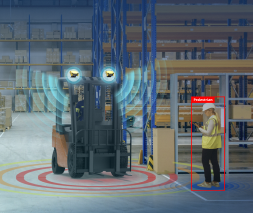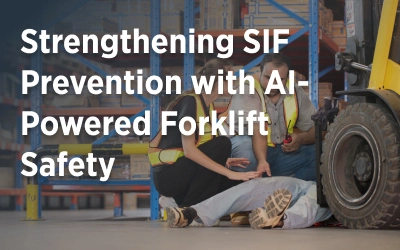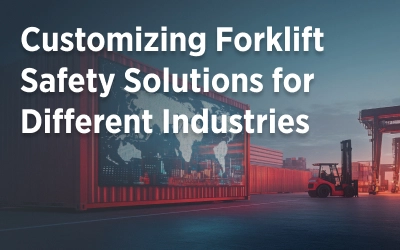Forklifts are indispensable to many industrial operations but pose significant safety risks if not managed properly. The balance between operational efficiency and safety protocols is one that industries constantly navigate.
In such industrial workplaces, adherence to the Occupational Safety and Health Administration (OSHA) standards becomes more than just a regulatory formality; it emerges as a crucial pillar of workplace safety.
This article focuses on the OSHA standards and regulations for forklift safety compliance and innovative solutions to meet these standards with use case examples.
What is Forklift Safety Compliance?
Forklift safety compliance involves adherence to regulations and standards established by the Occupational Safety and Health Administration (OSHA) to promote the safe operation of forklifts in the workplace. Forklift safety compliance aims to minimize the risk of accidents and injuries associated with forklift use, a common concern in industrial and warehousing environments.
Key elements include verifying that forklift operators receive proper training according to OSHA's guidelines, conducting regular maintenance and inspections to confirm the forklifts' safe working condition, and following safe operating procedures as outlined by OSHA.

Understanding OSHA Standards for Forklift Operations
OSHA's guidelines for forklift operations form the backbone of safety in industrial settings. These standards cover a wide range of aspects, from operator training to equipment maintenance, all designed to minimize accidents and enhance worker safety. Understanding and implementing these guidelines is key to maintaining a safe working environment.
Here's a breakdown of the key standards determined by OSHA documentation titled Powered Industrial Trucks, 1910.178:
- Forklift Training and Certification: OSHA requires proper operator training and forklift certification. This training should cover formal instruction (like lectures, written materials, or videos) and practical training (demonstrations and practical exercises). Operators must also undergo an evaluation to confirm that they can operate a forklift safely and get their certifications. (Reference article: 29 CFR 1910.178(l))
- Regular Inspections: Forklifts must be inspected daily or after each shift if used around the clock. This includes checking for damage and ensuring that all safety features function correctly. (Reference article: 29 CFR 1910.178(q)(7))
- Maintenance and Repairs: Forklifts must be maintained to ensure they operate safely. Any forklift found to require repair, defective, or unsafe must be taken out of service until it is restored to safe operating condition. (Reference article: 29 CFR 1910.178(q)(1))
- Age Requirements: OSHA standards prohibit individuals under 18 from operating forklifts. (Reference article: 29 CFR 1910.178(l)(6))
- Safe Operation: This includes adhering to the manufacturer's instructions, following site-specific rules, and general safety practices like observing speed limits, wearing seat belts, and following guidelines for loading and unloading. (Reference article: 29 CFR 1910.178(n))
- Work Environment Considerations: OSHA also sets standards for the work environment where forklifts are operated, such as clearance heights, aisle width, and floor loading. (Reference article: 29 CFR 1910.178)
Trio Mobil's Commitment to Forklift Safety Compliance
At Trio Mobil, our dedication to forklift safety compliance is firmly aligned with the rigorous standards of the Occupational Safety and Health Administration (OSHA).
Our approach to enhancing safety in forklift operations is comprehensive and holistic:
- Adherence to OSHA Training Standards: Recognizing the critical importance of proper training per OSHA’s requirements, our solutions are designed to complement and enhance the training process of the forklift operator. We facilitate adherence to OSHA’s mandate for comprehensive training and certification, making it easier for organizations to meet these crucial safety standards.
- Innovative Safety Technologies: We integrate advanced safety technologies in our forklift solutions to align with OSHA’s guidelines for safe operation. These technologies aid in regular equipment inspections and maintenance, which are critical components of OSHA’s regulations, leading to safe operational practices at all times.
- Supporting Safe Work Environments: We understand that the work environment is critical for forklift safety. Our solutions are tailored to assist organizations in maintaining compliance with OSHA's regulations regarding workplace safety. This includes preventing forklift accidents and other environmental factors crucial for safe forklift operation as per OSHA standards.
- Continuous Improvement and Compliance: Our priority is to stay updated with the latest OSHA updates and industry best practices. We continuously refine our products and services to achieve compliance with OSHA regulations, enhancing safety in the ever-evolving industrial landscape.

Innovative Technologies: Trio Mobil’s Role in Enhancing Forklift Safety
At Trio Mobil, our commitment to enhancing forklift safety through innovative technologies is closely aligned with the Occupational Safety and Health Administration (OSHA) standards.
Here's how our technology solutions contribute to forklift safety compliance:
Real-Time Monitoring Systems Aligned with OSHA Standards
Our sophisticated forklift tracking solutions, which provide real-time insights into forklift operations, are designed to support compliance with OSHA's regulations for equipment safety.
By tracking movements and identifying potential hazards, these systems help prevent accidents and create a safer work environment, in line with OSHA's guidelines.
Automated Safety Alerts for OSHA Compliance
The automated safety alerts in our technology can immediately notify operators and supervisors of potential safety breaches. Our high-precision proximity detection technology enables real-time automated safety alerts.
This capability is crucial for maintaining a high level of safety compliance, prompting quick and automated actions that help reduce incident risk, an essential aspect of OSHA’s forklift safety requirements.
Forklift Collision Avoidance Systems to Meet OSHA Safety Norms
Our forklift collision avoidance systems, using advanced sensors to detect proximity between forklifts and other MHEs or pedestrians, significantly reduce the likelihood of forklift collisions. Our AI cameras also effectively detect pedestrians and forklifts with image recognition and processing technology. We have the most comprehensive solution set for forklift safety, from UWB technology to AI cameras.
This technology supports adherence to OSHA’s regulations on operational safety and workplace hazard prevention.
Data Analytics for Safety Management
Our data analytics capabilities align with OSHA’s focus on proactive safety management.
By analyzing operation and leading safety indicators data via forklift fleet management, we help companies identify safety trends and risk areas, enabling them to take measures to enhance safety and comply with OSHA standards.
Case Studies: Trio Mobil's Success in Improving Forklift Safety Compliance
Trio Mobil's success in improving forklift safety compliance is best illustrated through real-world client success stories that showcase the practical application and effectiveness of their technologies.
Here are some examples:
Case Study #1: Large Manufacturing Facility
At a major manufacturing plant, the introduction of Trio Mobil's forklift safety system significantly decreased operational accidents. The real-time monitoring system provided immediate alerts for potential safety issues. This helped in averting accidents and cultivated a culture of safety awareness among the forklift operators. The facility saw a remarkable improvement in adherence to OSHA safety standards, demonstrating the effectiveness of Trio Mobil's solutions in a high-demand industrial environment.
Case Study #2: Warehouse and Logistics Company
A logistics company faced challenges with forklift safety compliance across its multiple warehouses. After implementing Trio Mobil's advanced forklift safety solutions, the company experienced a marked improvement in safety compliance. The technology's capability to facilitate better training processes and enhance safety awareness among operators led to a more informed and cautious workforce. The implementation reduced safety incidents, improved compliance with OSHA regulations, and increased operational efficiency.
Case Study #3: Retail Distribution Center
Trio Mobil's forklift safety systems were deployed in a retail distribution center to streamline safety audits and enhance overall safety operations. The systems' automated features and data analytics allowed for more efficient monitoring and quicker response to potential safety issues. As a result, the distribution center observed a notable decrease in safety violations and an enhanced ability to maintain continuous compliance with safety regulations.

Trio Mobil’s Forklift Safety Systems
Trio Mobil's forklift safety systems embody the cutting edge in industrial safety technology. These systems are designed to be comprehensive, addressing various aspects of forklift safety, from proximity detection to environmental hazard detection. Features like automated alerts, collision avoidance sensors, and pre-op checklists are just some of how these systems enhance safety and compliance. By integrating these advanced solutions, Trio Mobil aligns with OSHA's rigorous safety standards. It promotes a safety culture that goes beyond basic compliance, promoting a safer and more efficient working environment.










